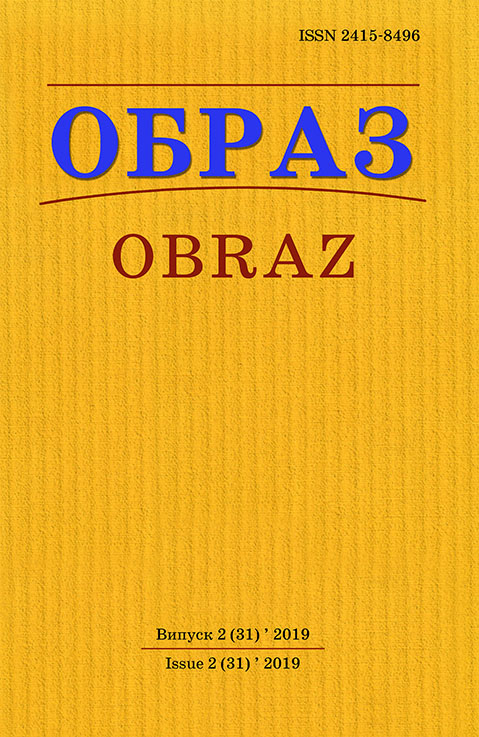Abstract
Introduction. The author’s emotions which reflected in the text are one of the topical issues in the study of journalism. By communicating with the reader through the text the author shares his feelings and experiences with him, affects his perception of the work and the formation of his own assessments not only at the level of logical judgments, but also at the level of emotions. At the same time, the emotions expressed in the text determine the image of the author of a journalistic work. One of the greatest emotional genres is the author’s column. The aim of the research is to identify the manifestations of emotional attitude to the object of reflection in the author’s columns of the online version of the magazine «L’Officiel Ukraine». Methodology. The main method of research is content analysis, which involves the search of literary and stylistic means of expressing the conception and certain language markers pointing to the author’s emotional attitude towards the object of reflection in the texts. By matching the different texts of each author and comparing them with the texts of other authors defined emotional dominant which inherent in each of the analyzed columnists. Results. The columns of three authors of the magazine “L’Officiel Ukraine” are analyzed. Each of them has its own style and subject matter, respectively, the objects of reflection in these texts are different, but very often the authors use similar language tools which indicate their emotional factors. The preferences and views of publicists leave remarkable mark in their writings. Considering the texts of each author, we noticed that the emotional dominant of texts is mostly stored. Conclusions. Each author demonstrates his own emotional attitude to the object of reflection through the use of certain literary and stylistic tools. The author’s column is the most personality-oriented genre, which allows journalists to independently choose a topic according to their own preferences and interests. The emotionality of the texts of each author, as well as his relation to the object of reflection, for the most part remains unchanged. Thus, the personality of the author is revealed already at the first stages of work on the text - the choice of the topic. In addition, there is an interaction between the author and the reader since the perception of a text saturated with certain emotions forms in the minds of the reader the image of the author and his own emotional response to both the described problem and the journalist.
References
1. Belyanin, V.P. (2000), Osnovy psicholingvisticheskoy diagnostiki (Modeli mira v literature) [Fundamentals of Psycholinguistic Diagnosis (World models in literature)] / Trivola, Moscow, Russia
2. Zdorovega, V. Y. (2004) Teoriya i metodika zhurnalIstskoyi tvorchosti [Theory and methodology of journalistic creativity], Lviv: PAIS, Ukraine
3. Izard, Kerrol E. (2000), The Psychology of Emotions [Per. s angl.], SPb. i dr.: Piter, Russia
4. Kroychik, L. E. (2000), System of journalistic genres, Osnovyi tvorcheskoy deyatelnosti zhurnalista [Fundamentals of journalist’s creative activity] : ucheb. [red. sost. S. G. Korkonosenko]. – SPb. : Znanie, SPb IVESEP, Russia
5. Potebnya, A.A. (1989) Thought and language, Slovo i mif [Word and myth], Pravda, Moscow, Russia
6. Svalova M. (2016), “Psychology” of the author-reader interaction in the structure of the author’s column (based on materials by Y. Andrukhovych and O. Gembik), Suchasniy mas-medIyniy prostir: realiyi ta perspektivi rozvitku: materIali II Vseukrayinskoyi naukovo-praktichnoyi konferentsiyi (12–13 zhovtnya 2016 r.) [nauk. red. V.M. Kalenich]. Vinnitsya, Ukraine
7. Chernikova, E. V. (2005), Osnovyi tvorcheskoy deyatelnosti zhurnalista [Fundamentals of journalist’s creative activity], Gardariki, Moscow, Russia
8. Shklyar, V. (2009), The author’s image: compositional-speech aspect, Obraz, Iss.10. P. 9–10.
9. Yatsimirska, M., Dragan, N. (2007), Mediatekst as a product of journalistic creativity (psycholinguistic analysis of logical perception and emotions), Visnik Lvivskogo un-tu Seriya zhurnalistika, Iss. 30, P. 267–276
10. Khomenko T. (2018) Dialogical foundation of the publicist’s communicative ethics: dialogical levels of the “Communicative pyramid”. Social Communication Volume 1, 25-32
11. O mode iz ofitsialnyih istochnikov [Elektronniy resurs], L’Officiel Ukraine, available at: https://officiel-online.com/redakcija.

This work is licensed under a Creative Commons Attribution 4.0 International License.
